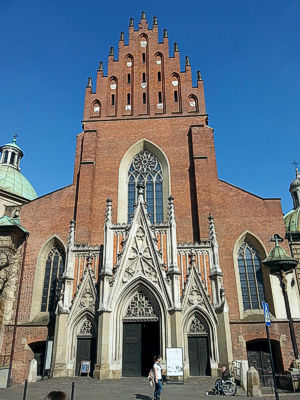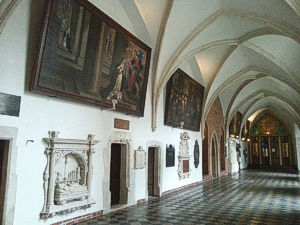|

Krakow’s Basilica of the Holy
Trinity and Dominican monastery
The large Dominican church of
the Holy Trinity at Stolarska street and Dominikanska
street, a three-minute walk from the Rynek Glowny central
square, is a fine example of the Krakow version of Gothic
architecture. It dates back to the mid-13th century and has
been the stronghold of the Black Friars ever since. In 1850
the church suffered badly in the great fire that destroyed
ten percent of the historic city of Krakow. And,
unfortunately, the subsequent reconstruction hasn’t been
quite accurate though it’s certainly unnoticeable to the
untrained eye.
In 1957 Pope Pius XII has
granted the title of a minor basilica to Krakow’s church of
the Holy Trinity.
The vast Dominican monastery
that adjoins the Basilica of the Holy Trinity was founded by
Saint Jacek Odrowaz, better known abroad under his Latin
name Hyacinth or San Jacinto in Spanish, who died in Krakow
in 1257 and whose relics are enshrined at the church in an
upstairs sanctuary-chapel.
In 1289 Duke Leszek II the
Black, the ruler of Poland from 1279, was buried next to the
high altar of the church of the Holy Trinity. In the ensuing
centuries it became popular among Poland’s aristocrats as a
burial ground, which has resulted in number of
mausoleum-chapels. Most interesting of them is the Chapel of
St. Dominic (Kaplica
sw. Dominika), also known as the Chapel of the
Myszkowskis (Kaplica Myszkowskich), the last but one in the right-hand aisle,
which dates from 1614 and can boast bas-relief portraits of
16 members of the Gonzaga-Myszkowski family who were buried
here. In 1642 a picture of Saint Dominic was placed in the
chapel’s altar and it soon became famous for miracles.
 Pilgrim's guide to Krakow
Pilgrim's guide to Krakow
The Krakow shrine of Saint Jacek
/Saint Hyacinth O.P./
The Chapel of St. Hyacinth (Kaplica
sw. Jacka) overlooks the nave of the Basilica of the
Holy Trinity. It’s reached by broad, easy stairs alongside
the wall of the left-hand aisle of the church. A grille
secures St. Hyacinth’s richly decorated mausoleum of 1700
and the glorious baroque altar/tomb with his relics standing
in the middle of the room. According to tradition the chapel
was originally the monastery cell where Saint Jacek lived in
the 13th century. Better known abroad under his Latin name
Hyacinth, he was born in 1183 to a Polish aristocratic
family and died in Krakow in 1257. This first Polish
Dominican friar ever earned himself a reputation of being
the Apostle of the North on the strength of his extensive
missionary work in Carinthia, Moravia, Bohemia, Russia, and
Prussia. He also helped to establish the Dominican monastery
in Krakow as early as 1222.
Sanctuary of Our Lady of the
Rosary
The church of the Holy Trinity
has been known for its sanctuary of Our Lady of the Rosary
since 1668. It’s located in the 17th-century Chapel of the
Rosary (Kaplica
Rozancowa) with its entrance at the far end of the
right-hand aisle of the church. Since 1668 the chapel has
enshrined the miraculous picture of Our Lady of the Rosary,
placed in the high altar of the chapel. The painting is a
copy of the famous image called
Salus Populi Romani,
worshipped in Basilica di Santa Maria Maggiore in Rome.
Another image of Madonna, placed in one of the side altars
of the Chapel of the Rosary (the one facing the entrance),
depicts the Blessed Virgin Mary dressed in a frock of a
Dominican nun. It was brought from Rome to Krakow in the
18th century and for a long time compared favorably with the
picture of Our Lady of the Rosary in the number of reported
miracles.

Krakow’s monastery of the Black
Friars
The Basilica of the Holy Trinity abuts one of three
cloisters of the vast Dominican monastery which extends to
the north. The 14th-century cloister is accessible both from
the left-hand aisle of the church and through the monastery
gate at Stolarska street. The spacious cloister exhibits
historic pictures showing miracles that involved the Black
Friars and scenes from the history of the Dominican Order as
well as portraits of Dominican monks who were Polish bishops
in the 13th, the 14th, and the 15th centuries. For many
decades the Dominican monastery and basilica have been
particularly popular with Krakow students who find here
spiritual guidance, intellectual stimulation, and place
where they can engage in good works of all kinds.
Visitor information for the
Basilica of the Holy Trinity and the Dominican monastery
The Basilica of the Holy Trinity at 12 Stolarska street and
Dominikanska street is situated on the eastern edge of the
Old Town historic district, just a three minutes’ walk from
Krakow’s Rynek Glowny central square. The church stays open
from 7 am to 8 am or longer but tourists should refrain from
visiting when there is a church service.
On Sundays and major Catholic feasts the Holy Mass takes
place in the Basilica of the Holy Trinity at 8 am, 9 am,
10.30 am, noon, 1.30 pm, 3.30 pm (except July and August), 5
pm, 7 pm, 8.20 pm, and 9.30 pm. And at 7 am, 8 am, 9 am,
noon, 5 pm, 6 pm, and 7.30 pm on weekdays and Saturdays.
|
Pilgrimage
sites in Krakow
In the footsteps of Pope John Paul II
Krakow, Poland
Historic
churches in Krakow
Poland’s second holiest shrine at the site of St.
Stanislav’s 1079 martyrdom. Splendid Baroque church and fine
monastery modeled on a Renaissance castle.
Hilltop monastery-fortress dates from the 11th century.
Magnificent 17th-century Baroque hermitage complex atop
the Silver Mountain hovers over Krakow.
Vast fortified complex on the Vistula river is home to
Krakow’s once powerful Premonstratensian Sisters since the 12th
century.
|





